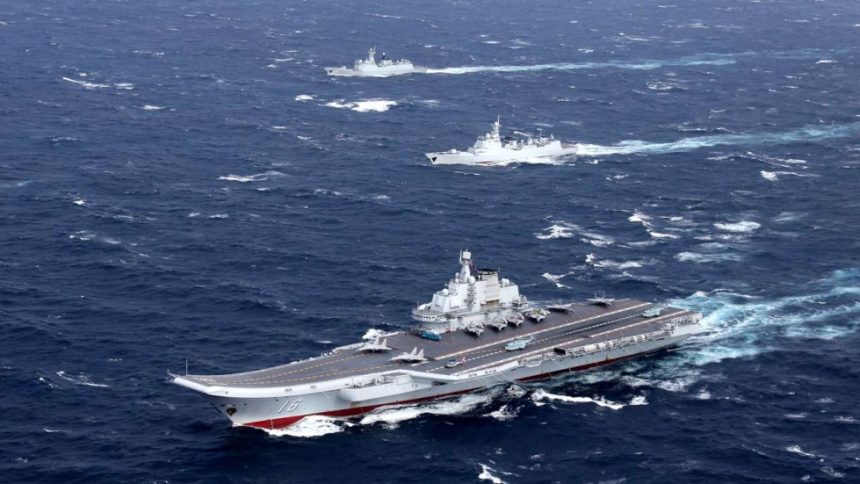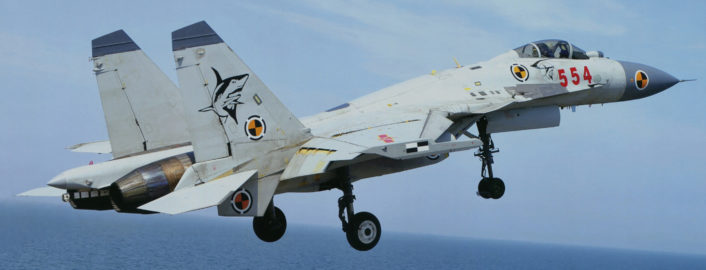Chinese Carrier Liaoning Crosses Taiwan Air Defense Identification Zone: Provokes Taiwanese Response.
Media and intelligence sources report the Chinese Aircraft Carrier Liaoning has crossed the politically sensitive Taiwanese Air Defense Identification Zone (ADIZ) along with several escort ships. The Liaoning sailed up the west side of the median line of the strait separating the Chinese mainland from Taiwan.
The Chinese government issued a release stating the Liaoning and her support vessels were conducting drills to test weapons and equipment in the disputed South China Sea and that these operations are in compliance with international law.
In response, Taiwan dispatched patrol and fighter aircraft to monitor the passage of the Liaoning group. The Taipei Times reported a similar incident on Tuesday, Dec. 27th, 2016. During that incident people in the city of Hualien photographed Taiwanese F-16 and RF-16 aircraft taking off in response to the sighting of the Liaoning in monitored waters. Reports also indicate that Taiwan’s E-2K Hawkeye and P-3 Orion aircraft were dispatched to the area to maintain patrol and surveillance. These same aircraft likely responded to this passage of the Liaoning.
In unrelated activity in the western Pacific region, on Jan. 9, 2017 the U.S. Marines deployed ten F-35B Lightening II STOVL aircraft from Marine Fighter Attack Squadron 121 (VMFA-121), the “Green Knights” to Marine Corps Air Station Iwakuni on Honshu Island in Japan. The squadron is part of the 3rd Marine Aircraft Wing from Marine Corps Air Station (MCAS) Yuma.
Although the deployment to Iwakuni is not a direct U.S. response to escalating tensions in the region as it represents a planned phase of the normal operational integration of the F-35B force for the U.S. Marine, the deployment of the most advanced American aircraft to the region has also a symbolic value.
MCAS Iwakuni is approximately 2,000 kilometers (1,079 nautical miles) northeast of central Taiwan. Range of the F-35 is generically reported as 1,200 nautical miles (2,200 kilometers) with a stated combat radius of 625 nautical miles (1,158 km) unrefueled.
The F-35B STOVL variant is intended for shipboard operations however, and was recently tested on board the amphibious assault ship USS America (LHA 6) that is currently operating from the west coast of the United States for deployment in the Pacific theatre. USS America is one of three amphibious assault ships in this class that also includes the USS Tripoli (LHA 7) and USS Bougainville (LHA 6).
The Liaoning (Chinese CV-16) has a complex history.
It started life as a Russian (then Soviet) Navy Kuznetsov class carrier christened the Riga and launched in late 1988. It was the largest Russian naval ship ever built. The ship was re-named the Varyag in 1990 after nearly being commandeered by Ukraine. The Chinese initially had a plan to repurpose the ship as a floating casino, but China eventually elected to use the vessel as a training aircraft carrier and presumably a full-scale feasibility study for the operation and development of new Chinese aircraft carriers.
China is well underway in construction of their second aircraft carrier, the Type 001A now designated the Chinese CV-17. The new carrier is an indigenous Chinese design that does still use the ski-jump style aircraft launch technique as opposed to a steam or magnetic driven catapult as with U.S. carriers. That only one of these new Chinese-engineered carrier class vessels is under construction suggests that China may be developing another, more advanced carrier class. Additionally, intelligence indicates the Chinese are developing an indigenous magnetic catapult launch system.
Reports in Chinese media indicate that the Liaoning has an onboard compliment of 36 aircraft total. They include up to 24 Shenyang J-15 Flying Shark fighters that are reported to be restricted from carrying heavy strike weapons by take-off performance on board the ship according to Russian media. If accurate, this limits these aircraft to the air superiority role while flying from Liaoning. The J-15 Flying Shark is analogous to the Russian Su-33, sharing a plan form similar to the entire Su-27 series of Sukhoi aircraft.
The remainder of the ship’s compliment is limited to rotary wing aircraft including the Changhe Z-18F anti-submarine patrol helicopter and the “J” variant of the Z-18 helicopter configured for airborne early warning. The ship also reportedly carries two smaller Harbin Z-9C helicopters for rescue operations, an important role given the experience of the Russian carrier in anti-ISIL operations off Syria.
Given the aircraft onboard Liaoning currently the ship’s role is limited, in an operational sense, to air security patrol. The ship’s aircraft have no strike or even heavy anti-ship capability beyond its ASW helicopters.

















